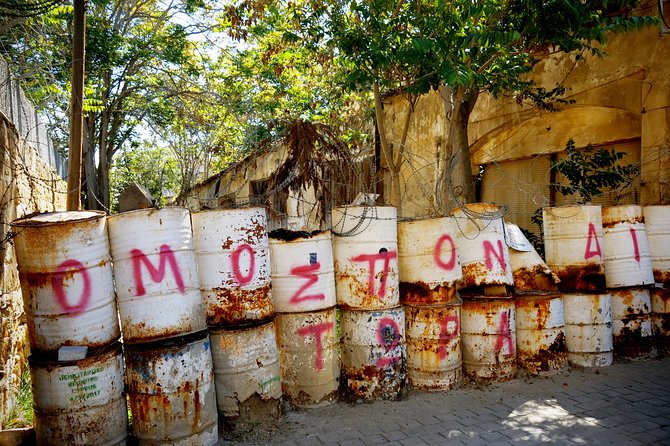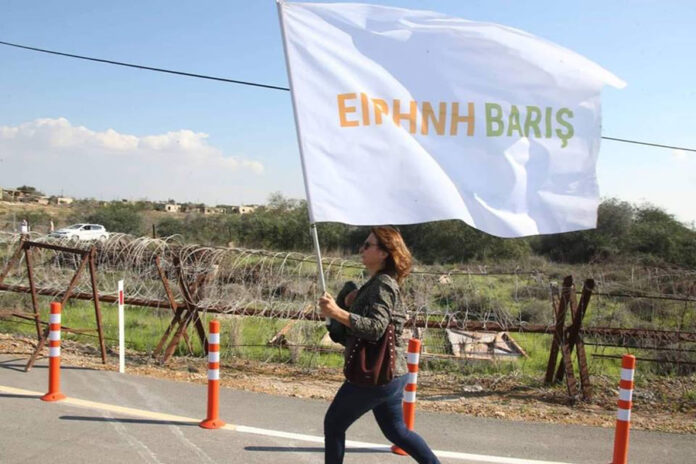On this day, April 23, 2003, the first checkpoint was opened at Ledra Palace in Nicosia.
After 29 years, Greekcypriots and Turkishcypriots would cross the “Green Line” again.
The opening of the checkpoints was a result of the pressure from the Turkishcypriot movement against the Denktash regime.
Let’s examine the general framework behind these developments.
Crisis in the north
In December 1999, the banking sector in northern Cyprus began to collapse as a result of the economic crisis that hit Turkey. Six banks collapsed at the beginning of 2000 and came under government control. Four out of the six banks closed down leaving hundreds unemployed and thousands of depositors went bankrupt. For the survival of the remaining banks, for the functioning of the state and for the compensation of those who lost their deposits, the Eroglu government (of the National Unity Party – the party of Denktash) asked for financial assistance from Ankara.
Turkey, in the grip of its own economic crisis, received funding from the IMF in November 2000. While Turkey had been funding the Turkish Cypriot community as a “motherland” since the 1960s, for the first time it asked for guarantees in return for the funding. And so, the first Protocol between Turkey and the TRNC (Turkish Republic of Northern Cyprus) is signed, which is in essence the first austerity package. The measures included in the package were met with massive resistance from the opposition parties and trade unions, and so the funding was slowed down and the government delayed the payment of wages for public servants and the compensation payments to the victims of the financial crisis.
All this happened after the 1990s, when the embargo on Northern Cyprus was extended as Britain stopped importing goods from the north and most hotels and factories were sold off to private owners.
Mass mobilisations
Thousands of Turkishcypriots had been on the streets since 2000; 41 organisations, trade unions, opposition parties, ect, formed the platform “This Country Is Ours”.
In 1999, it was agreed that Cyprus would join the European Union in 2004, regardless of whether a solution to the Cyprus problem had been reached. In November 2002, a new plan for a solution to the Cyprus problem was submitted by UN Secretary-General Kofi Annan. The Turkishcypriots, who were already on the streets, placed their hopes to these two events.
The mobilisations at the end of 2002 and the beginning of 2003 were huge. On February 27, 2003, the demonstration called by the Platform, according to Reuters, was attended by 70-80,000 people, about half of the population of northern Cyprus, which then numbered 160,000 inhabitants including settlers.
The slogans of the demonstrations were clearly against the regime and in favour of a solution to the Cyprus problem. “Denktash resign”, “Peace in Cyprus will not be prevented”, “This country is ours” were the most typical.
For three years the repression of the movement escalated. There were raids on trade union headquarters, confiscation of computers, arrests of trade unionists, prosecutions with sentences of up to four and a half years in prison. In the latest mobilisations, Denktash ordered the army and police to close all possible crossing points to the south in case the Turkishcypriots opened the barricades with their bodies.
The opening of the checkpoints
Eventually the size of the movement forced the Denktash regime to open the Ledra Palace checkpoint on April 23, 2003. This was followed four days later by the opening of the Strovilia and Pergamos checkpoints, on April 27, 2003. Less than a month later, on May 19, 2003, the Agios Dometios/Kermia checkpoint was opened.
This decision by the Denktash regime was taken in order to calm the movement down, but also to “reveal the true face” of the Greekcypriots. Denktash believed that the Greekcypriots would not be happy with such a move and that they would prevent the Turkishcypriots from getting through. Indeed, the Greekcypriot establishment was not happy with this development. But the Greekcypriot workers, young and old, embraced the opening of the checkpoints, defied the Greekcypriot nationalists and crossed to the other side in the thousands already on the first day. In the first 15 days alone, 260,000 Greekcypriots visited the northern part of the island, while 90,000 Turkishcypriots visited the southern part. In fact, during the first 15 days, 40% of the island’s population crossed the checkpoints!
Neither side expected the clear message of reconciliation sent by the thousands of Greekcypriots and Turkishcypriots, who crowded the checkpoints and waited patiently for hours in order to pass through to the other side.
The missed opportunity and AKEL
The fraternity of the two communities that was achieved in that period was far superior to any attempt to resolve the Cyprus problem in its 50-year history. The massive mobilisations of the Turkiscypriots in early 2003 showed that when people decide to take their fate into their own hands there are no limits to what they can achieve.
Unfortunately, the AKEL (Progressive Party of Working People) leadership, continuing its well-known policy of alliance with the bourgeoisie (formerly with supporting Makarios, then Kyprianou, then Vassiliou and then Tassos Papadopoulos), in 2003 supported Papadopoulos’ candidacy, proclaiming that “Tassos has changed”. They later became trapped in their choices and were turned into the main defender of Papadopoulos’ ‘rejectionist’ and dead-end policy by opposing the Annan plan.
The (Stalinist) stages theory (“first solve the national problem and then put forward our own programme for socialism”) suited the AKEL leadership as much as it could present Makarios, Kyprianou and Vassiliou as “progressive bourgeoisie” figures. Unfortunately, this policy seemed like a farce in 2003, with AKEL’s allies representing the most reactionary part of the bourgeoisie, not only in terms of the national question but also in the socio-economic field, with the implementation of the most unpopular, neoliberal programme up to that moment in the history of Cyprus.
The uprising of the Turkishcypriots and the opening of the checkpoints provided a unique opportunity to build a common front of struggle between Greekcypriot and Turkishcypriot workers. This opportunity was lost. For this opportunity to become a reality, to become concrete and take shape, it would have to be reflected in a concrete political programme and action. Otherwise it would have evaporated, as it did.

What should AKEL have done?
If AKEL had been a genuine left-wing party, it would have taken a number of initiatives such as the following:
- It would have declared the full support of the Greekcypriot masses, from the very first moment, for the uprising of the Turkishcypriots and would have proceeded to organise mass events, mobilisations, concerts, etc. in the buffer zone, calling for the immediate opening of the checkpoints.
- It would have organised, after the opening of the checkpoints, mass visits of Greekcypriots to the north and of Turkishcypriots in the south to the towns and villages of their origin, combining them with mass fraternisation events.
- It would proceed to the creation of local people’s committees for rapprochement and fraternity between the Greekcypriot and Turkishcypriot communities in every town and every village, networking them at a pan-Cypriot level.
- It would have invited the representatives of the Turkishcypriot movement to talks in order to work on a mutually acceptable solution to the Cyprus problem, a solution not given by an international bourgeois organisation but one that would be born out of the needs and for the needs of the workers on both sides.
- Together with the movement of the Turkishcypriots, they would have developed a corresponding movement of Greekcypriots that would include debates throughout society on the proposals of the Left, which, in combination with joint mass mobilisations, would aim at changing the government. It should have declared the aim of election governments of the Left, in the north and the south, on the basis of a programme for the implementation of the proposed solution as would result from the thorough and meaningful participation of society.
But in the absence of this alternative perspective from the side of the Left, the Turkishcypriots embraced the Annan Plan and EU membership as a lifeline for reunification and for escaping isolation.
Reaction of the nationalist right
The Greekcypriot establishment, the nationalist centre and the right wing, from the very first day of the opening of the checkpoints started a terror campaign. The myths on which the whole non-solution of the Cyprus problem was based, namely that the Turkishcypriots do not want a solution and that Denktash is keeping the checkpoints closed, collapsed within a day. So after the opening of the checkpoints a new propaganda campaign started. The main argument was that by showing a passport at the checkpoints the “pseudo-state” would be recognised. Also, that Denktash was opening the checkpoints to let Turkish military agents through or that there would be a mass invasion of Turkishcypriots from Ledra Palace. Even Haravgi (the newspaper of AKEL), unfortunately, on April 23, 2003, had a front page headline that the opening of the checkpoints was “Denktash’s plot”, and that the “National Council considered the decision of the occupation regime illegal”.
The communication between the two communities and the relations that have developed since the opening of the checkpoints frightens the ruling classes on both sides even today.
Today, the only party in Cyprus which is publicly against the opening of new checkpoints and in favour of the closure of all the others is the neo-Nazi ELAM (National Popular Front). But we should note that in the days before the opening of the Deryneia checkpoint in 2018, EDEK (nationalist social democrats), Solidarity (a far-right splinter of DISI), the Greens and Citizens’ Alliance (centre-right) also presented their statements against it. EDEK even held an event against the opening of the Deryneia checkpoint which was attended by DIKO (centre right nationalists) members.
The movements open the checkpoints
The ruling classes on both sides, in order to maintain the status quo and nationalism, if they could keep the checkpoints closed, they would. It was telling that at the beginning of the pandemic the first crossings to be closed were the checkpoints and not the airports.
All the checkpoints that have been opened since 2003 have been opened through joint struggles of Greekcypriots and Turkishcypriots from the Left, the trade unions and peace activists.
The dynamics of the mobilisation was revealing when it was decided to close the checkpoints due to the pandemic in 2020. The demonstrators then, with their own bodies, managed to break the police cordon and open the checkpoints on their own.
In the 461 days that the checkpoints remained closed, the demand for their reopening remained alive with mobilisations on both sides of the Green Line.
The opening of the checkpoints is a step towards the reunification of the island. It demolishes myths promoted by nationalists about the “other” community while giving space to movements, whether environmental, feminist, or LGBTQI+ to act in unity across the island.
After the collapse of the talks in 2017, it became even more obvious that the ruling classes in Cyprus on both sides neither want nor are able to solve the Cyprus problem because they have conflicting interests.
It is time for the movements on both sides to put forward new goals:
- the opening of further checkpoints at essential crossing points
- the simplification of controls
- the establishment of shared services, such as insurance and telecommunications, so that mobility between the two sides of the island can be made as easy as possible.
- and, above all, the creation of a bicommunal reunification movement based on the acceptance of political equality, within the framework of a socialist federal solution.



